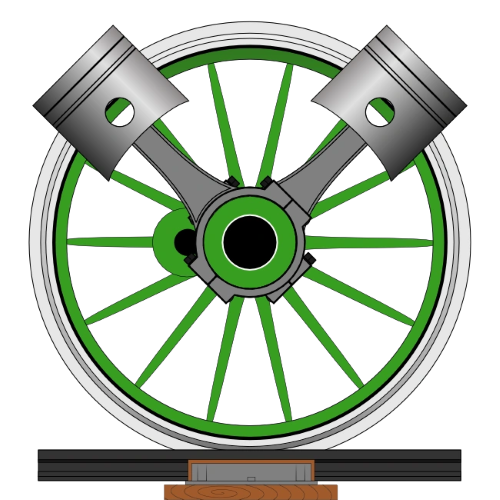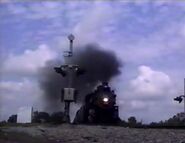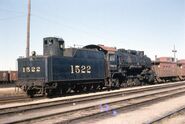St. Louis & San Francisco Railroad "Frisco" No. 1522 is a T-54 (1500) class 4-8-2 "Mountain" type steam locomotive built by the Baldwin Locomotive Works of Philadelphia, Pennsylvania in 1926 for the St. Louis–San Francisco Railway, also known as the Frisco. The 1522 was built to handle Frisco's heavier passenger trains through the hilly Ozark regions. Five other examples of Frisco Mountain-type locomotives are preserved today throughout America.
The 1522 was retired around 1951, later being saved and donated to the National Museum of Transportation in St Louis, Missouri. Later, the SLSTA started restoration on the locomotive in 1985 and the 1522 entered its second career in 1988. Due to money increasing on its career, it returned to retirement in 2002 and is now placed on permanent static display at the Museum of Transportation in Kirkwood, Missouri, near St. Louis.
1522's Excursions[]
- 1988: Inaugural run to Decatur, Illinois.
- 1989: Inaugural run to Moberly, Missouri.
- 1990: 1522 pulled a 22-car excursion over Rolla Hill during the 1990 NRHS annual convention. The locomotive also did a doubleheader excursion with the Union Pacific No. 844 for the convention.
- 1994: 1522 was one of the locomotives to participate in the 1994 NRHS annual convention in Atlanta, Georgia and did a doubleheader with the Norfolk & Western No. 611 from Birmingham, Alabama to Atlanta, Georgia on its way to the convention.
- 1995: 1522 was the special guest of the annual haymarket heyday and did several excursions between Omaha and Lincoln, Nebraska.
- 1999: While on a test run following an 18-month overhaul, 1522 derailed on a wye in North St. Louis, Missouri. A rail overturned under the fireman's side as the locomotive was moving onto the wye, causing extensive damage to the running gear. The damage was repaired and the locomotive returned to service a few months later with help from the Tennessee Valley Railroad Museum.
- 2001: 1522 was invited to pull the Burlington Northern Santa Fe annual employee appreciation special which included a historic tour through the state of Texas. One week later, 1522 was invited to pull several excursions for the 2001 NRHS annual convention.
- 2002: It was announced that 1522 was to be put back into retirement as the result of increased insurance rates. On September 28 and 29th, 2002. 1522 did a farewell excursion and was put back on display on November 2nd, 2002.
several excursions not listed.
Trivia[]
- Many railfans regard No. 1522 as the "The Loudest Steam Locomotive in the World" due to its exceptionally loud exhaust blasts, particularly when working hard.
- Although it is possible for No. 1522 to run again, the museum has stated that a return to service isn't possible anytime soon, largely due to the locomotive's flue sheet being damaged beyond repair (a new one would have to be fabricated, and new flues would be needed before another steam-up).
- In 1995, No. 1522 was used in the filming of the HBO movie, "Truman", starring Gary Sinise. In the film the locomotive was pulling the President's train of Harry Truman.
- The St. Louis Steam Train Association selected No. 1522 for restoration to operational condition in 1985.
- No. 1522 once had a CB&Q 5-chime whistle in 1995.
- After No. 1522 was officially retired from excursion service in late September 2002, its auxiliary water tender and crew cars were eventually sold off to other steam operators, including the Age of Steam Roundhouse and the Friends of the 261.
- Five other examples of Frisco 4-8-2 type locomotives are preserved today throughout the United States.
- No. 1522 is the only 4-8-2 type locomotive to have ever operated in mainline excursion service in the United States during the post excursion service era.
- No. 1522 once had a CB&Q 5-chime whistle in 1995. It was also used as the whistle of The Oceanic Express from SpongeBob SquarePants and many other movies, commercials, and TV shows and also its Hancock 3-chime.
- All scheduled steam operations ended on the Frisco in February 1952 and reserve steam operations ended in 1956.












